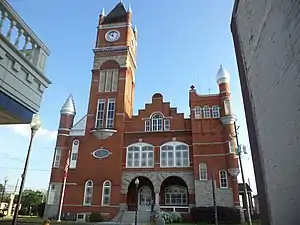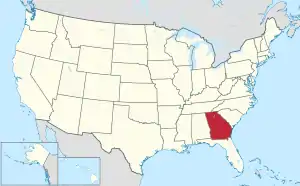Terrell County | |
|---|---|
 Terrell County Courthouse in Dawson | |
 Location within the U.S. state of Georgia | |
 Georgia's location within the U.S. | |
| Coordinates: 31°47′N 84°26′W / 31.78°N 84.44°W | |
| Country | |
| State | |
| Founded | February 16, 1856 |
| Named for | William Terrell |
| Seat | Dawson |
| Largest city | Dawson |
| Area | |
| • Total | 338 sq mi (880 km2) |
| • Land | 335 sq mi (870 km2) |
| • Water | 2.3 sq mi (6 km2) 0.7% |
| Population (2020) | |
| • Total | 9,185 |
| • Density | 27/sq mi (10/km2) |
| Time zone | UTC−5 (Eastern) |
| • Summer (DST) | UTC−4 (EDT) |
| Congressional district | 2nd |
| Website | www |
Terrell County is a county located in the southwestern portion of the U.S. state of Georgia. As of the 2020 census, the population was 9,185.[1] The county seat is Dawson.[2] Terrell County is included in the Albany, GA metropolitan statistical area.
History
Formed from portions of Randolph and Lee Counties on February 16, 1856, by an act of the Georgia General Assembly, Terrell County is named for Dr. William Terrell (1778–1855) of Sparta, Georgia, who served in the Georgia General Assembly and the United States House of Representatives.[3]
During the American Civil War, after Atlanta's capture by Union forces, a refugee settlement was established in Terrell County for civilians forced to flee the city. The Fosterville settlement, named after Georgia Quartermaster General Ira Roe Foster,[4] was according to author Mary Elizabeth Massey in her 2001 history, the "most ambitious refugee project approved by the Georgia General Assembly" [during that period].[5] On March 11, 1865, the Georgia General Assembly authorized General Foster to "continue to provide for maintenance of said exiles, or such of them as are unable by their labor to support themselves, or their families for the balance of the present year."[5]
During the civil rights era of the 1960s, the local white minority resisted change, sometimes violently; it subsequently became known as "Terrible Terrell County".[6] In 1958 the county refused to register a group of African-Americans including several teachers with Bachelors and master's degrees on the grounds that they couldn't read, and a college-educated marine who was refused registration on the grounds he could not write intelligibly.[7][8] The case eventually reached the supreme court, and the county was ordered to allow them to register, but they did not immediately comply. In 1960, testimony showed that Black voters were given more tests, and more difficult tests, than White voters, and that illiterate Whites were allowed to vote, while well-educated Blacks were falsely determined to be illiterate. The county asserted that this was not discriminatory.[9] In September 1962, an African-American church was burned down after it was used for voter registration meetings.[10] (Note: Like other southern states, Georgia had disenfranchised most blacks at the turn of the century by rules raising barriers to voter registration; they were still excluded from the political system.) That month Prathia Hall delivered a speech at the site of the ruins, using the repeated phrase "I have a dream." Rev. Martin Luther King Jr. attended her speech; afterward, he also began to use that phrase, including in his noted "I Have a Dream" speech in 1963 at the Lincoln Memorial in Washington, DC.[11]
Geography
According to the U.S. Census Bureau, the county has a total area of 338 square miles (880 km2), of which 335 square miles (870 km2) is land and 2.3 square miles (6.0 km2) (0.7%) is water.[12]
The western and southern two-thirds of Terrell County is located in the Ichawaynochaway Creek sub-basin of the ACF River Basin (Apalachicola-Chattahoochee-Flint River Basin). The county's northeastern third is located in the Kinchafoonee-Muckalee sub-basin of the same larger ACF River Basin.[13]
Major highways
Adjacent counties
- Webster County - north
- Sumter County - northeast
- Lee County - east
- Dougherty County - southeast
- Calhoun County - southwest
- Randolph County - west
Communities
Demographics
| Census | Pop. | Note | %± |
|---|---|---|---|
| 1860 | 6,232 | — | |
| 1870 | 9,053 | 45.3% | |
| 1880 | 10,451 | 15.4% | |
| 1890 | 14,503 | 38.8% | |
| 1900 | 19,023 | 31.2% | |
| 1910 | 22,003 | 15.7% | |
| 1920 | 19,601 | −10.9% | |
| 1930 | 18,290 | −6.7% | |
| 1940 | 16,675 | −8.8% | |
| 1950 | 14,314 | −14.2% | |
| 1960 | 12,742 | −11.0% | |
| 1970 | 11,416 | −10.4% | |
| 1980 | 12,017 | 5.3% | |
| 1990 | 10,653 | −11.4% | |
| 2000 | 10,970 | 3.0% | |
| 2010 | 9,315 | −15.1% | |
| 2020 | 9,185 | −1.4% | |
| U.S. Decennial Census[14] 1790-1880[15]1890-1910[16] 1920-1930[17] 1930-1940[18] 1940-1950[19] 1960-1980[20] 1980-2000[21] 2010[1] | |||
| Race | Num. | Perc. |
|---|---|---|
| White (non-Hispanic) | 3,189 | 34.72% |
| Black or African American (non-Hispanic) | 5,540 | 60.32% |
| Native American | 11 | 0.12% |
| Asian | 57 | 0.62% |
| Pacific Islander | 1 | 0.01% |
| Other/Mixed | 210 | 2.29% |
| Hispanic or Latino | 177 | 1.93% |
As of the 2020 United States census, there were 9,185 people, 3,399 households, and 2,348 families residing in the county.
Politics
Terrell County has consistently been a Democratic county since the 1992 presidential election, though the margins have historically been close. In 1940, Franklin D. Roosevelt received 100% of all votes cast in Terrell County.
| Year | Republican | Democratic | Third party | |||
|---|---|---|---|---|---|---|
| No. | % | No. | % | No. | % | |
| 2020 | 2,004 | 45.38% | 2,376 | 53.80% | 36 | 0.82% |
| 2016 | 1,874 | 44.58% | 2,267 | 53.92% | 63 | 1.50% |
| 2012 | 1,834 | 41.62% | 2,544 | 57.73% | 29 | 0.66% |
| 2008 | 1,890 | 42.75% | 2,501 | 56.57% | 30 | 0.68% |
| 2004 | 1,859 | 48.58% | 1,951 | 50.98% | 17 | 0.44% |
| 2000 | 1,504 | 48.31% | 1,584 | 50.88% | 25 | 0.80% |
| 1996 | 1,111 | 40.33% | 1,509 | 54.77% | 135 | 4.90% |
| 1992 | 1,143 | 32.90% | 1,942 | 55.90% | 389 | 11.20% |
| 1988 | 1,517 | 52.22% | 1,383 | 47.61% | 5 | 0.17% |
| 1984 | 1,744 | 52.18% | 1,598 | 47.82% | 0 | 0.00% |
| 1980 | 1,378 | 40.29% | 2,010 | 58.77% | 32 | 0.94% |
| 1976 | 1,168 | 33.22% | 2,348 | 66.78% | 0 | 0.00% |
| 1972 | 2,057 | 74.99% | 686 | 25.01% | 0 | 0.00% |
| 1968 | 545 | 15.06% | 1,276 | 35.26% | 1,798 | 49.68% |
| 1964 | 1,921 | 77.15% | 569 | 22.85% | 0 | 0.00% |
| 1960 | 285 | 17.41% | 1,352 | 82.59% | 0 | 0.00% |
| 1956 | 203 | 13.51% | 1,300 | 86.49% | 0 | 0.00% |
| 1952 | 369 | 21.16% | 1,375 | 78.84% | 0 | 0.00% |
| 1948 | 100 | 10.52% | 608 | 63.93% | 243 | 25.55% |
| 1944 | 49 | 2.90% | 1,639 | 97.10% | 0 | 0.00% |
| 1940 | 0 | 0.00% | 1,040 | 100.00% | 0 | 0.00% |
| 1936 | 61 | 4.36% | 1,336 | 95.50% | 2 | 0.14% |
| 1932 | 24 | 2.34% | 1,000 | 97.37% | 3 | 0.29% |
| 1928 | 116 | 11.45% | 897 | 88.55% | 0 | 0.00% |
| 1924 | 45 | 6.47% | 630 | 90.52% | 21 | 3.02% |
| 1920 | 48 | 8.76% | 500 | 91.24% | 0 | 0.00% |
| 1916 | 13 | 1.78% | 677 | 92.74% | 40 | 5.48% |
| 1912 | 12 | 2.23% | 500 | 93.11% | 25 | 4.66% |
Notable people
- Benjamin J. Davis Jr., Harvard Law School graduate and elected to New York City Council. Defended Angelo Herndon in Georgia against insurrection charges for organizing a union, resulting in a U.S. Supreme Court case that ruled against Georgia's insurrection law as unconstitutional.[24]
- Walter Washington, activist and politician, elected as the first black mayor of Washington, D.C.[24] after Congress granted home rule to the city.
- Otis Redding, rhythm and blues singer; one of the first crossover artists appealing to both young blacks and whites in the post-World War II era.
- Cole Swindell, is an American country music singer and songwriter who attended Terrell Academy in Dawson, Georgia.
See also
References
- 1 2 "U. S. Census Bureau". United States Census Bureau. Archived from the original on December 18, 2021. Retrieved October 26, 2022.
- ↑ "Find a County". National Association of Counties. Retrieved June 7, 2011.
- ↑ Krakow, Kenneth K. (1975). Georgia Place-Names: Their History and Origins (PDF). Macon, GA: Winship Press. p. 224. ISBN 0-915430-00-2. Archived (PDF) from the original on September 17, 2003.
- ↑ Lisa Tendrich Frank (2008). Women in the American Civil War. ABC-CLIO. p. 113. ISBN 978-1-85109-600-8.
- 1 2 Mary Elizabeth Massey (2001). Refugee Life in the Confederacy. Louisiana State University Press. p. 246. ISBN 978-0-8071-2688-2.
- ↑ Wicker, Tom (August 14, 1977). "Still 'Terrible Terrell'". The New York Times.
- ↑ "Terrell County Georgia Civil Rights Act vote register". The Macon Telegraph. September 5, 1958. p. 1.
- ↑ "High Court revives Terrell voting suit". The Atlanta Constitution. March 1960. p. 1.
- ↑ "Vote testing said unfair". The Macon Telegraph. June 29, 1960. p. 1.
- ↑ "Welcome to the Civil Rights Digital Library". crdl.usg.edu. Retrieved March 22, 2018.
- ↑ Holsaert, Faith et al. Hands on the Freedom Plow: Personal Accounts by Women in SNCC. University of Illinois Press, 2010, p. 180.
- ↑ "US Gazetteer files: 2010, 2000, and 1990". United States Census Bureau. February 12, 2011. Retrieved April 23, 2011.
- ↑ "Georgia Soil and Water Conservation Commission Interactive Mapping Experience". Georgia Soil and Water Conservation Commission. Archived from the original on October 3, 2018. Retrieved November 24, 2015.
- ↑ "Decennial Census of Population and Housing by Decades". US Census Bureau.
- ↑ "1880 Census Population by Counties 1790-1800" (PDF). US Census Bureau. 1880.
- ↑ "1910 Census of Population - Georgia" (PDF). US Census Bureau. 1910.
- ↑ "1930 Census of Population - Georgia" (PDF). US Census Bureau. 1930.
- ↑ "1940 Census of Population - Georgia" (PDF). US Census Bureau. 1940.
- ↑ "1950 Census of Population - Georgia -" (PDF). US Census Bureau. 1950.
- ↑ "1980 Census of Population - Number of Inhabitants - Georgia" (PDF). US Census Bureau. 1980.
- ↑ "2000 Census of Population - Population and Housing Unit Counts - Georgia" (PDF). US Census Bureau. 2000.
- ↑ "Explore Census Data". data.census.gov. Retrieved December 18, 2021.
- ↑ Leip, David. "Dave Leip's Atlas of U.S. Presidential Elections". uselectionatlas.org. Retrieved March 22, 2018.
- 1 2 "An Overview of the Brazier Case", Georgia Civil Rights Cold Cases Project, Emory University, accessed 6 April 2016
External links
- terrellcounty.georgia.gov
- The New Georgia Encyclopedia Terrell County entry Archived March 7, 2006, at the Wayback Machine